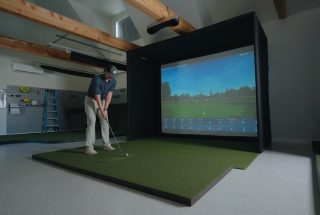Study finds most female players tackle courses that are too long
NEW YORK, N.Y., Feb. 2, 2011 – According to the “fairness test” devised by Arthur D. Little and Jann E. Leeming, women golfers are being asked to play courses that are generally more than 1,000 yards too long for them to reach greens in regulation.
In a recent posting on their blog, Golf With Women (http://www.golfwithwomen.com), Little asks the following questions:
• How fair is a 5,600-yard course for the average woman?
• What would you think if we told you that a 5,600-yard course would be equivalent to an 8,400-yard course for the average man?
• How about an 11,200-yard course for Matt Kuchar?
If the average woman should play from 5,600 yards, the average LPGA player should be playing a 9,600-yard course and a good male amateur should play a 10,400-yard course, Little contends.
“That’s how the math works if ‘fair’ is defined as having to hit the same clubs to reach greens in regulation from their respective tees,” Little writes. “This concept is what we define as the ‘fairness test.’ Sorry, Dustin Johnson, you are at 12,320 yards based on your average drive of 308 yards.”
According to Little and Leeming, the “average women golfer” hits her tee shot 140 yards. Hence, based on the data they have collected in their research, the length of the course she should play in order to have the opportunity to reach greens in regulation is 4,200 yards. Note that this is 30 times her average drive, which, Little adds, turns out to be a very good rule of thumb for everyone.
He goes on to note that the average male golfer hits a drive of 210 yards, while Kuchar’s average drive of 280 yards is within a few of yards of the PGA Tour average in 2010.
“If the woman is at 4,200 yards, the average male golfer should be playing tees at 6,300 and the average PGA pro should be at 8,400 yards,” he writes. “These yardages seem much more reasonable, even though 8,400 yards is approximately 900 yards longer than the longest courses played on the PGA Tour. No wonder those guys are good!”
A graph that accompanies the blog posting shows that the average woman is asked to play courses that are generally more than 1,000 yards too long for her to meet the “fairness test” of reaching greens in regulation. The yardage for the average male is just about right, observes Little, who adds that better players usually play courses that are close to 1,000 yards shorter than would be indicated by multiplying their average drive by 30.
“The problem is that there are very few 4,200-yard golf courses in the United States, never mind the world,” Little writes. “As a result, most women golfers do not have the choice of a set of tees that gives them a fair chance to hit greens in regulation and thus give them the opportunity to score well.”
Little and Leeming believe the idea of courses with sets of tees that fit players with a wide range of driver swing speeds (from 60 to 110-plus mph) is critical. He writes that courses built (or retrofitted) this way will be more fun for all and much faster to play, and points to Old MacDonald Course at Bandon Dunes as one such shining example.
“We neither realistically believe courses will be built that are long enough to ‘fit’ players with faster than average swing speed, nor do we support such an effort – 7,500 yards is plenty long enough,” he writes.
Little offers this advice for players when choosing their yardage:
• Play a course where the yardage is approximately 30 times your average drive. If a course is longer than this, it will be a lot less enjoyable.
• If you don’t really know how long you hit your average drive (most people significantly overestimate), use two times your average nine-iron yardage. If you are among the great majority (98 percent) of golfers, this will be accurate.
• If your 30 times calculation results in a number shorter than the most forward set of tees at the course you are going to play, Little encourages them to read the “Move On Up” post to see how to deal with this situation.
The complete “What’s Fair?” posting, and accompanying graph, as well as other postings, can be found by visiting http://www.golfwithwomen.com.
Contact:
Karen Moraghan
Hunter Public Relations
908/876-5100
kmoraghan@hunter-pr.com



